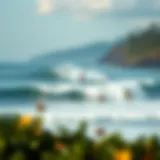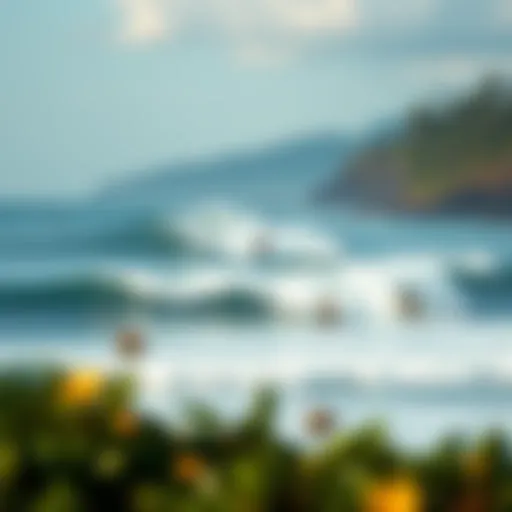Discover Malibu Point: The Ultimate Surfing Guide
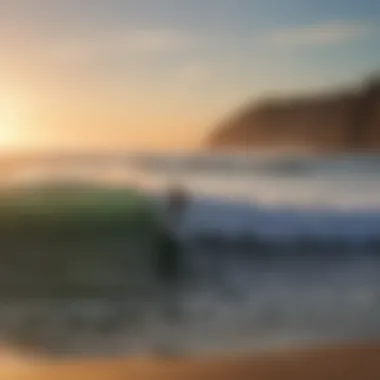

Intro
Malibu Point, a name that resonates in the hearts of surfing aficionados, is more than just a beach; it's a legendary spot where waves and sunsets create an unforgettable tapestry. Nestled along the stunning Californian coastline, this location is known for its remarkable surf conditions that attract both seasoned professionals and enthusiastic beginners. The intoxicating blend of glowing skies and roaring waves presents not just a surfing experience but also a lifestyle that many aspire to.
To appreciate what Malibu Point offers, one must delve into its historical significance, environmental concerns, and the nuances that define its surfing conditions. From discussing which surfboards are best suited for the unique waves to exploring essential surfing techniques, this guide aims to paint a vivid picture of the Malibu surf scene. Whether you’re looking to ride the waves for the first time or are sharpening your advanced skills, understanding the intricacies of Malibu Point can significantly enhance your experience.
The location’s allure extends far beyond its iconic breaks; it's about the community and culture that thrives there.
Surfboard Reviews
Surfing is a craft that demands not only skill but also the right equipment. Choosing the right surfboard is crucial, and at Malibu Point, where the waves can be robust, the right board makes all the difference. This section will cover the types of surfboards available and highlight the best options for both beginners and advanced surfers.
Types of Surfboards: An Overview
Understanding the different types of surfboards will help you choose something that caters to your ability and the specific conditions at Malibu Point. Here’s a breakdown of the most common types:
- Shortboards: Typically under seven feet, they are ideal for experienced surfers looking for speed and maneuverability on steep waves. These boards are often a go-to at Malibu due to its powerful swells.
- Longboards: Ranging from nine to twelve feet, these boards are perfect for beginners and those who prefer a more relaxed surfing style. The increased buoyancy makes catching waves easier, which is invaluable for novices.
- Fish Boards: A hybrid that offers a balance between shortboards and longboards, they have a shorter length with wider tails, making them great for smaller waves and quick turns.
- Funboards: These are versatile boards, usually around the 7 to 8-foot mark, and can be a great transition for beginners leaping from a longboard to a shortboard. They're forgiving and suitable for various conditions.
Best Surfboards for Beginners and Pros
For beginners, a reliable longboard could be your best friend at Malibu Point. Here are a couple of suggestions:
- BIC Sport Paulownia 9'0" Longboard: Known for its stability and ease of use, this board can withstand the beginner's inevitable wipeouts while still allowing progression in skills.
- Torq 7'0" Soft Top Funboard: With a soft deck and great flexibility, it's forgiving yet offers a glimpse into performance surfing that will ease novices into the sport.
On the other hand, more experienced surfers looking to tackle the powerful waves at Malibu might consider:
- Channel Islands Pilot Shortboard: This high-performance option excels in various surf conditions, allowing for quick, agile maneuvers on steeper waves typical of Malibu.
- Lost Puddle Jumper: With its unique design and ability to generate speed on smaller waves, it's a favorite among many advanced surfers navigating the point's varying swells.
"Choosing the right surfboard is akin to finding the perfect companion for your surfing adventure; it should enhance your experience rather than hinder it."
Whether you're a novice eager to catch your first wave or a pro looking to refine your moves, recognizing the type of surfboard that suits your style is vital. Next, we’ll delve deeper into the surfing techniques, which are essential in honing your skills at Malibu Point.
Overview of Malibu Point
Malibu Point is not just a surf spot; it is a cornerstone of surf culture that captivates enthusiasts across the globe. This section takes a closer look at what makes this location so important for surfing. From its pristine views to its consistent swells, understanding Malibu Point helps surfers prepare for their adventure and appreciate the dynamics at play.
Historical Context
Malibu has a storied past tied to its natural beauty and surf legacy. Before surfboards graced its waters, the area was home to the Chumash people, whose deep connection to the land goes back thousands of years. These indigenous inhabitants revered the ocean as a source of life, an attitude that remains relevant in today's surf culture.
Fast forward to the mid-20th century, when surf culture exploded, and Malibu became a hotspot. Legends like Jeffreys and the original Z-Boys frequented its waves, carving it into the annals of surf history. Understanding this context enriches the experience for modern surfers by linking them to the rituals and stories of those who rode the waves before.
Geographical Features
The geographical layout of Malibu Point plays an essential role in its reputation as a surfing paradise.
Coastal Topography
The coastal topography of Malibu Point features natural cliffs and sandy beaches that create a dynamic shoreline. These cliffs provide a striking contrast to the ocean's azure, offering a backdrop that is both stunning and functional. They not only shape the waves but also protect the area from some of the more destructive weather patterns that could degrade the beach. The unique feature here, the underwater canyons, creates deep water waves ideal for experienced surfers looking for that rush.
Advantages abound; the reliable waves produced by this topography attract both novice and seasoned surfers alike. However, the cliffs also pose risks, particularly for beginners who may find themselves swept too close to rock formations if they lose control.
Wave Dynamics
Wave dynamics at Malibu Point are a complex ballet governed by both wind and swell conditions. The point often serves as a meeting point for various swell directions thanks to its geographical position, meaning that it can benefit from waves generated by both southern and northern swells.
A key characteristic here is the beach break, which allows surfers to experience a range of wave forms—gentle rollers for newcomers and powerful barrels for the more accomplished. This variety enhances Malibu's appeal, providing something for everyone. The challenge, however, is that the wave heights can fluctuate rapidly, and experienced surfers need to be vigilant of the changing conditions.
Overall, understanding these geographical features lays a solid foundation for any surf enthusiast stepping into the waves of Malibu Point. From its rich history to the intricate wave dynamics, every aspect contributes to the allure of this iconic surfing destination.
Malibu Point's Surf Conditions
Understanding the surf conditions at Malibu Point is essential for surfers looking to ride its famous waves. Known for its diverse surfing experience, Malibu Point provides various conditions that could cater to all skill levels. Factors such as seasonal changes, wave dynamics, and the characteristics of the breaks make it crucial to know these elements before hitting the waters. Surf conditions not only influence the enjoyment of your session but also affect safety and performance.
Optimal Surf Seasons
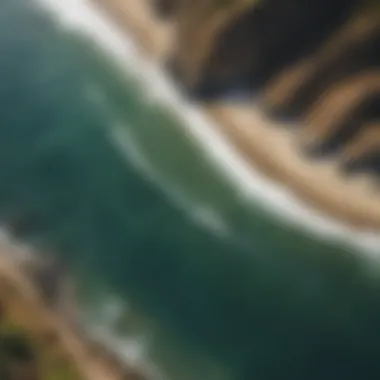

Optimal surf seasons play a significant role in shaping a surfer's experience.
Winter Swells
The winter months at Malibu Point bring substantial swells, with waves reaching impressive heights. One specific aspect to highlight is how these winter swells offer larger and more powerful wave opportunities. For many surfers, late autumn through early spring becomes an eagerly anticipated period, and Malibu sees a flood of seasoned surfers seeking out these conditions.
Key characteristics of winter swells include their consistency and strength. These waves tend to form due to larger storms in the Pacific, which, while providing thrilling rides, also bring increased challenges. The unique feature of these swells is the adrenaline-pumping power they offer, making this period a beloved choice for many.
However, these advantages come with some disadvantages. The marked strength of winter waves can intimidate less experienced surfers and increase the risk of accidents. A proper understanding of one’s skill level is essential during this period, especially due to rapidly changing conditions.
Summer Conditions
As the warm sun sets in during summer, the surf conditions also morph, and Malibu Point transforms into a haven for beginner and intermediate surfers. The specific aspect of summer conditions lies in the gentler waves, which attract those looking to refine their skills or simply enjoy a relaxed day on the water.
Key characteristics of summer conditions include softer waves that break consistently, creating an inviting environment for novices. These mellow waves provide an excellent opportunity to enhance paddling and catching techniques. The unique feature here is the diversity of waves at Malibu Point during summer, ideal for various surfing styles.
However, while summer might be less intimidating for beginners, it also brings its specific challenges. The crowds can be thick, leading to potential hazards with other surfers in the lineup. Understanding surf etiquette becomes paramount to ensure a safe and enjoyable experience for all.
Wave Characteristics
Wave characteristics dictate not just the surfing experience but also safety measures.
Break Type
The type of break at Malibu Point is one critical aspect to consider when selecting a spot to surf. Malibu features both left and right-hand breaks, with the most famous being the right-hand break that peels off the point. The characteristics of this break make it an attractive choice for many surfers.
Many surfers find the right-hand break beneficial because it can offer longer rides, ideal for practicing turns and maneuvers. Furthermore, the point setup provides a unique experience as waves wrap around in a predictable manner, allowing surfers to anticipate movements better.
On the flip side, this popular break can be crowded, raising concerns about collisions and competition for waves. Surfers should remain vigilant and respectful to others in the lineup to maintain a smooth surf session.
Height and Power
The height and power of waves at Malibu Point vary significantly, dictated largely by the season and swell conditions. A notable characteristic of these waves is the range they present; some can occasionally reach beyond six feet. This range attracts experienced surfers, providing them with thrilling challenges.
What makes the height and power of Malibu Point's waves particularly beneficial is the opportunity they present for significant progression in skills. Riders can push their limits and tackle more challenging waves.
Nevertheless, this height also introduces an inherent risk, especially for those less familiar with surf dynamics and rescue methods. Learning to read the waves' power is crucial for embracing the exhilarating experience Malibu Point has to offer.
Ultimately, understanding Malibu Point's surf conditions is fundamental for making the most of this revered surfing location. Surfers can tailor their approach to different seasons and wave characteristics, ensuring an enjoyable and safe experience.
Surfing Techniques at Malibu Point
To truly harness the waves at Malibu Point, surfers must grasp the nuances of various surfing techniques. Whether you're new to the sport or a seasoned rider, understanding these techniques can enhance both skill and experience. This section aims to unpack effective practices suitable for beginners as well as advanced surfers, emphasizing the importance of adapting to the unique characteristics of Malibu Point. The waves here call for precision, creativity, and the ability to read conditions effectively.
Best Practices for Beginners
Staying Motivated
In the world of surfing, staying motivated is half the journey. Surfing isn’t just about catching waves; it’s about riding the emotional rollercoaster that comes with learning and growing as a surfer. The waves can be fickle, and frustration can sometimes creep in. An important characteristic of maintaining motivation is setting realistic goals. When a beginner tracks their progress, be it improving paddling strength or standing up on the board, it fosters a positive mindset.
Additionally, finding a supportive community can offer a treasure trove of encouragement. Local surf groups or online forums where fellow surfers share lessons, triumphs, and even setbacks can help foster a sense of belonging.
However, it’s vital to recognize that motivation can fluctuate. For some, taking a break might be necessary to avoid burnout. The unique feature of approaching motivation from a community perspective can galvanize beginners, leading them to refresh their love for surfing by surrounding themselves with others who share their passion.
Essential Skills
Considered as the backbone of surfing, essential skills play a pivotal role for those starting out. Progressive skill-building allows surfers to navigate the waves with increased confidence. Key characteristics of essential skills include mastering paddling, balance, and knowing when to duck dive under oncoming waves.
The idea of developing balance goes beyond simply standing on a board; it’s about understanding the nuances of shifting your weight effectively. Learning to stay centered while riding a wave significantly impacts a surfer's control and ability to execute maneuvers. This skill helps beginners transition into more advanced skills over time.
One distinct advantage of focusing on these essential skills is their long-term applicability. A grasp on fundamental techniques sets the stage for more complex riding styles. In contrast, neglecting them may hinder progress, leading to discouragement for new surfers. Thus, approach surface basics with patience and dedication.
Advanced Riding Tips
Carving Techniques
As surfers advance, the focus shifts to refining techniques like carving. This aspect revolves around making clean, fluid turns on the wave face, showcasing style and control. In essence, carving enables surfers to ride the wave's energy more efficiently. Its key characteristic is the transitioning of weight and angle. This effortless shift allows for maintaining speed while altering direction.


The beauty of carving lies in its aesthetic and performance aspect. It not only looks visually appealing but also boosts the overall wave-riding experience. However, one needs to recognize that improper techniques in carving can lead to wipeouts. Learning and honing this skill in a safe environment, perhaps on smaller waves, can aid in building confidence gradually.
Wave Positioning
In conjunction with carving, wave positioning takes precedence in advanced surfing. This is all about knowing where to be when the wave breaks. Understanding how to read the wave direction and timing your movement can make or break the ride. A crucial characteristic of effective wave positioning is intuitive judgment coupled with a deeper understanding of wave dynamics, unique to each surfing spot.
The advantage here lies in the surfer’s ability to maximize their ride. When positioned correctly, surfers can catch the wave with minimal effort while gaining the best possible speed and power. However, it can take time and repetitive practice to develop this skill. New surfers are encouraged to observe others and learn from their positioning to grasp how it impacts their ride. This perspective can immensely improve their surfing technique over time.
Safety Protocols in Surfing
Safety in surfing isn't just about avoiding wipeouts; it encompasses a broad spectrum of practices that ensure a fun-filled and secure day out on the waves. Each surf session brings a different set of conditions, making it crucial for surfers—new and seasoned alike—to be aware of the risks and how to manage them effectively. Understanding safety protocols not only enhances the surfing experience but also safeguards the wellbeing of both individual surfers and those around them. This section will dive into vital safety protocols, including how to deal with rip currents and the essentials of first aid.
Understanding Rip Currents
Rip currents can be a surfer's worst enemy, often catching even the most experienced by surprise. These narrow channels of fast-moving water flow away from the shore, leading to potentially dangerous situations if one is unprepared. Recognizing the signs of rip currents is vital. They usually appear as a stretch of water that is choppy and foamy, sometimes with a marked gap in the incoming wave pattern.
Here are some points to keep in mind:
- Observe Before You Dive: Look at how waves break and the water moves. If you see water flowing away from the beach, that could be a rip current.
- Swim Parallel: If caught in a rip, remember that panicking is not your friend. Instead, swim parallel to the shore until you find the current’s edges, then swim back to safety.
- Signal for Help: In an extreme situation, signal for assistance with a wave of your hand. Lifeguards are trained to spot signals quickly.
"Knowing about rip currents can mean the difference between a perilous swim back and an exhilarating surf session. Stay alert and surf smart!"
First Aid Essentials
Every surfer should carry a basic first aid kit, especially when venturing out to more remote spots like Malibu Point. A well-stocked kit can make all the difference in emergencies—from minor cuts to more severe injuries. Here’s what to include:
- Adhesive Bandages: Perfect for minor cuts or scrapes.
- Sterile Gauze Pads: For larger wounds that need more coverage.
- Antiseptic Wipes: To clean out any dirt and prevent infection.
- Elastic Bandage: Helpful for sprains or strains.
- Sunscreen: Always protect your skin, as sunburn can take away from your surfing experience.
- Water: Staying hydrated is crucial, especially in hot weather.
Additionally, being familiar with basic first aid procedures can be critical:
- CPR Training: Knowing how to perform CPR could save a life in severe situations.
- Wound Care: Understand how to clean and dress minor injuries to prevent infection.
- Know the Emergency Number: Always be aware of how to contact medical services when at or near the beach.
By integrating these safety protocols into your surfing routine, you'll not only enhance your personal experience but also contribute positively to the surfing community. Remember, safety in surfing isn’t just a list of rules; it’s about fostering a culture of care and responsibility.
Environmental Concerns
In the throbbing pulse of Malibu Point, where waves crash with fervent energy, lies a vital underlying theme that surf enthusiasts must not overlook: the environmental concerns connected to this iconic surf destination. The equilibrium of this unique ecosystem can significantly impact marine life and the overall experience of surfers. Understanding these elements not only enriches the surfing adventure, but it also reinforces a sense of responsibility among the community. The choices surfers make can either nourish or harm the marine environment, calling for a deeper appreciation of nature’s delicate balance.
Preserving Marine Life
Impact of Pollution
Pollution—an unwelcome shadow lurking in the waters, affecting marine life and surfing conditions alike. It manifests in various forms: plastic debris, oil spills, and runoff from urban areas. Each piece of litter not only tarnishes the natural beauty of Malibu Point but also poses a dire threat to the creatures inhabiting these waters. Fish, seals, and other marine life face distress and peril due to the toxins finding their way into their habitats.
A key characteristic of pollution is its pervasive nature. Most surfers might step onto their boards with excitement, but they must recognize the sacred responsibility they have for the ocean. The oceans' health reflects on surfers’ enjoyment levels, which turns the focus toward eco-conscious practices. While it’s easy to dismiss the trash seen along the shore as someone else’s problem, these keen eyes should see the interconnectedness—it’s a surfer's duty to ensure that the water remains clean for future generations. The unique feature of pollution is that it often goes unnoticed until significant damage occurs; hence, an awareness shift among the surfing community is crucial to mitigate its effects.
Conservation Efforts
In response to the creeping threat of pollution, conservation efforts bloom like resilient coastal wildflowers. These initiatives aim not just for temporary cures but aspire for long-term healing of fragile marine ecosystems. Agencies, non-profits, and local surfers band together to launch clean-up drives, educate communities, and establish programs that advocate for sustainable usage of coastal resources.
One vital characteristic of conservation efforts is their community-driven nature. When surfers come together to protect their beloved surf spots, they foster a sense of community pride. Whether it’s organizing beach clean-ups or pushing for stronger pollution regulations, these acts contribute to a healthier marine environment. They highlight a unique feature: the positive feedback loop of participating in conservation. As surfers engage and invest in preserving the ocean, they simultaneously enhance their own surf experiences. The added advantage of these initiatives is the awareness it generates; surfing becomes not just a sport but a movement toward a cleaner, more sustainable future.
Sustainable Surfing Practices
Eco-friendly Products
As surfers increasingly become aware of their ecological footprint, the shift toward eco-friendly products gains momentum. This includes biodegradable wax, recycled surfboards, and environmentally safe surf gear. These products lessen the burden on the planet while enhancing the surfing experience, ensuring that surfers can enjoy their passion without guilt.
The key characteristic of eco-friendly products is their sustainable production methods. Crafting surfing gear using materials that are less harmful to the environment resonates with conscientious surfers, marking a notable change in consumer behavior. Each purchase reflects a choice—a stance against pollution. For example, a biodegradable surf wax not only improves performance but also decomposes naturally, reducing waste entering the oceans. The unique feature of such products is that they align performance with consciousness, drawing in surfers who care deeply for the waves they ride.
Community Initiatives
Communities have the power to shape the surfing culture significantly. Community initiatives focused on sustainability provide a platform for surfers to rally around, engaging them in meaningful conversations about the ocean's health. From educational workshops to collaborative events that emphasize local eco-systems’ importance, these initiatives empower individuals.
One compelling aspect of community initiatives is their potential to foster connections. When surfers come together, they share knowledge, not only about the surf but also about the essential practices that protect their environment. The beneficial outcome of these initiatives is that they cultivate care for the ocean and the surrounding ecosystems. The unique feature lies in the social impact; it's about community-building through a shared commitment to sustainability. Local surfers can inspire newcomers or visitors, creating a collective consciousness toward responsible surfing that spreads like wildfire.
Malibu Point's Surf Culture
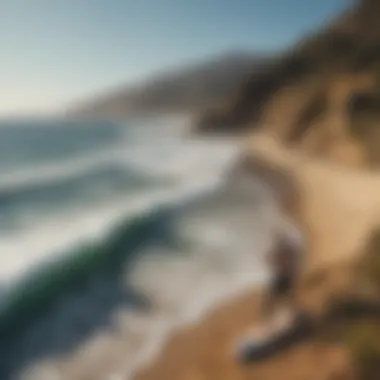

Malibu Point is more than just a geographic location; it embodies a rich tapestry of surf culture that has evolved and thrived over the decades. This culture is an essential element of the overall surfing experience in Malibu, engaging both locals and visitors in a unique lifestyle defined by camaraderie, competition, and an unwavering passion for the ocean. The surf culture here reflects a deep respect for the waves and the environment, making it significant not only for surfers but for anyone interested in coastal ecosystems and community-focused activities.
Local Surfers and Legends
The story of Malibu Point's surf culture would be incomplete without mentioning the legendary surfers who have left their footprints on its sands. From the dawn of surfing in California to contemporary influences, the local talent has continuously shaped the ethos of the scene.
Local Icons: Figures like Miki Dora and Tom Blake have etched their names into surfing history. Miki, in particular, represented the rebellious spirit of Malibu, often surfed the waves with an effortless style that captivated audiences. Today, modern surfers carry on this legacy, creating a community that thrives on individuality and creativity.
Influence on New Generations: Young surfers look up to these legends, not just for their skills but for their love for the ocean. The local surf shops and schools offer mentorship programs, pairing novices with seasoned surfers, ensuring that the wisdom and techniques of past and present remain alive in the community.
The Community Feel: Malibu is known for its social gatherings at the beach. Surfer meet-ups, barbecues, and surf film screenings create spaces where stories are told and friendships are formed. This sense of belonging goes beyond the water, fostering relationships that are essential to a vibrant surf culture.
Competitive Events and Tournaments
Competition is a significant aspect of Malibu Point's surf culture. The adrenaline of competitive events not only showcases local talent but also draws surfers from around the globe.
Key Competitions: Events like the Malibu Surfing Association Championships are staples in the calender, attracting an audience that spans generations. These tournaments celebrate both amateur and pro surfers, creating a platform where anyone can shine.
Nurturing Local Talent: Local competitions often serve as breeding grounds for upcoming surfers. The exposure gained during these events frequently leads aspiring athletes to pursue more extensive competitions, including events sanctioned by organizations like the World Surf League.
Community Engagement: What sets these tournaments apart is the local support they receive. Families and friends come together, lending support to their favorite competitors, creating an electric atmosphere that reinforces the values of sportsmanship and community spirit.
"Surfing is a way of life here. It’s more than catching waves; it’s about the friends you make and the stories you share."
So, whether you're riding your first wave or competing at a professional level, the surf culture at Malibu Point offers an experience that is inextricably linked to the ocean. This culture is more than just a backdrop; it is an ever-evolving narrative woven through the lives of those who call it home. Understanding it enriches every surfer’s connection to Malibu, transforming a simple surf trip into a meaningful adventure.
Navigational Insights
When one sets foot on the sandy expanse of Malibu Point, understanding the lay of the land isn’t just a helpful tip; it’s essential for getting the most from each surf session. Navigational insights dive deep into the logistical aspects that make your visit enjoyable and, importantly, safe.
Access Points and Parking
Getting to Malibu Point isn’t a maze, but it does require some knowledge of where to turn and where to park. There are several access points along the coast, each with its pros and cons.
- Topanga Beach Access: This spot is highly popular, especially during peak surf season. Parking can be a challenge, so arriving early can be your saving grace.
- Malibu Road: Here, several smaller access points allow you to dodge larger crowds. However, don’t forget coins for the parking meters or risk a fine!
- Paradise Cove: Slightly further down the road, a bit of a walk is rewarded here with fewer surfers to compete against, translating to a blissful ride. Just be aware of beach rules concerning parking.
Key Takeaway: Arriving early and knowing your preferred entry point can save time and frustration.
Local Amenities
While surfing takes center stage, the local amenities shouldn't be brushed aside. These provide necessary breaks and sustenance for your day by the waves.
Cafes and Restaurants
Exploring local cuisine adds richness to your surf experience. The eateries near Malibu Point serve everything from quick bites to sit-down meals.
- Café Bizou: Known for its relaxed vibe and delightful breakfast options, this spot ensures you’re fueled up for an active day. Their fresh juices are particularly praised.
- Malibu Farm: Situated on the pier, it transforms fresh ingredients into mouthwatering meals, offering stunning ocean views. Nothing beats a post-surf meal overlooking the waves, making it a popular choice.
Having access to diverse dining options not only allows you to replenish energy but also gives you a taste of the local culture. This portrayal reciprocates the unique coastal lifestyle Malibu embodies.
Equipment Rentals
Whether you're a seasoned pro or a beginner, the convenience of local surf shops offering equipment rentals can’t be denied. Many shops along Pacific Coast Highway cater to surfers’ diverse needs.
- Surf Rider Rentals: This shop is revered among locals, providing first-rate boards and wetsuits that fit well and perform excellently in the surf. Their friendly staff offers personalized advice based on surf conditions.
- Malibu Surf Shack: Known for its extensive selection, this shack serves both beginners and experienced surfers. The advantage here is that you can try different boards and find what suits your style best.
Accessing superior rental options enables surf enthusiasts to experience Malibu Point without the hassle and expense of carting equipment to the beach.
Surfing is about the experience, and so is everything around it—dining, equipment, and community. When you integrate these elements properly, every trip can become a memorable adventure.
In wrapping up this segment on navigational insights, it’s clear that success at Malibu Point goes beyond just tackling the waves. Familiarizing yourself with access points, parking situation, and local amenities creates a holistic surfing experience worth savoring.
Epilogue
The discussion around Malibu Point isn’t just about its famous surf breaks and turquoise waters; it embodies a complex interplay of culture, environment, and community. The significance of looking forward, specifically in the section on The Future of Malibu Point, extends beyond just surf conditions, touching on preservation efforts and surf culture.
Surfing here isn’t merely a pastime; it’s intertwined with the identity of both the locale and its people.
In Encouraging Responsible Surfing, we emphasize that with great waves comes great responsibility. Maintaining the ecological balance of this pristine location is crucial, and fostering a culture of care among surfers ensures that future generations can enjoy the same glistening waters we cherish today.
Taking these elements into account makes the conclusion of this guide paramount. It serves as a reminder not only to appreciate the surfing experience but also to promote sustainable practices. This way, we can continue to experience the adrenaline of catching a wave without jeopardizing the vibrant marine ecosystem that supports it.
In summary, Malibu Point stands as a microcosm of broader environmental and surf culture conversations. Let’s champion the future of a beloved surfing destination, ensuring it remains as breathtaking and inviting for years to come.












